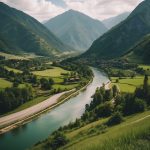Exploring the Amazon: The Best Guided Jungle Tours for Adventurers
Safety in the Jungle
Exploring the Amazon jungle can be a thrilling experience, but it requires careful attention to safety. Key aspects include understanding the terrain, handling wildlife and insects, and being prepared for emergencies.
Navigating the Terrain
The Amazon jungle’s terrain is diverse and challenging. Travelers must be aware of dense undergrowth, slippery paths, and uneven ground. Wearing suitable footwear, such as sturdy hiking boots, can prevent injuries.
Understanding the local weather conditions is essential, as rain can make trails more hazardous. Always follow a professional guide who is familiar with the area. They can identify safe routes and avoid natural hazards.
Carrying a map and a compass, even with a guide, is a wise precaution. This ensures that you can stay oriented and safe in case of unexpected situations.
Dealing with Insects and Wildlife
The Amazon is home to numerous insects and wildlife. Insects like mosquitoes can carry diseases; therefore, wearing long sleeves and using insect repellent is crucial. To avoid bites, use nets while sleeping.
Wildlife encounters require caution. Never approach or feed animals as this can provoke unpredictable behavior. Guides can help identify safe distances to maintain from various species.
Knowing how to react to specific animals can save lives. For example, with snakes, it’s important to stay calm and slowly back away. Familiarize yourself with common hazards in the area.
Emergency Procedures
Preparation for emergencies can make a significant difference. Always carry a basic first-aid kit that includes bandages, antiseptics, and any personal medications. Learning basic first-aid skills is advisable.
Communication devices like satellite phones are valuable, as they can function in remote areas. Ensure your guide has provisions for contacting help. Inform someone outside the jungle of your plans and expected return time.
In case of getting lost, stay calm and remain where you are to increase the chances of being found. Following these procedures ensures that even in emergencies, help is reachable and risks are minimized.
Photography Tips
To take stunning photos in the Amazon, the right equipment and methods for capturing wildlife are crucial. Specific tools and techniques help ensure that photographs are both clear and compelling.
Camera Equipment Recommendations
A high-quality DSLR or mirrorless camera with a weather-sealed body is ideal for jungle conditions. Lenses should range from wide-angle for landscapes to telephoto for capturing distant wildlife. A 70-200mm lens is versatile and useful for various shots.
A sturdy tripod helps stabilize the camera in low light conditions found under thick canopy cover. Since moisture and rain can be frequent, waterproof covers or bags protect equipment. Pack spare batteries and memory cards because charging options might be limited.
Capturing Wildlife
When photographing wildlife, patience and preparedness are key. The early morning and late afternoon light offer the best conditions. Staying quiet and minimizing movement helps avoid startling animals.
Using a telephoto lens helps capture details from a distance. Focus on the eyes of the animal for more engaging photos. Utilize burst mode to increase the chances of getting the perfect shot. Understanding animal behavior can anticipate their movements, leading to more successful photos.
Returning from the Jungle
After the exhilarating experience of a guided tour in the Amazon jungle, travelers need to ensure a smooth transition back to more comfortable surroundings and make plans for their onward journey.
Post-Tour Accommodations
Once the jungle tour concludes, it’s common for tour operators to arrange a night or two in a local lodge or hotel. These accommodations are generally located in nearby towns and offer a comfortable environment for winding down and reflecting on the adventure.
Rooms are typically equipped with modern amenities such as air conditioning, hot showers, and comfortable beds. Guests have the opportunity to enjoy meals featuring local cuisine, providing a delightful end to their jungle experience.
For those desiring more relaxation, many of these lodges offer optional activities like spa treatments, guided nature walks around the property, or visits to nearby cultural sites. This brief respite ensures that travelers are rested and ready to continue their travels.
Traveling to Your Next Destination
Planning the next leg of the journey is critical. Depending on the initial starting point of the tour, travelers may need to arrange transportation back to major cities like Manaus or Iquitos.
Options typically include small charter planes, riverboats, or shuttle services. Flights often need to be booked in advance, especially during peak travel seasons.
If using riverboats, travelers should be prepared for longer travel times but will enjoy scenic views along the waterway. Shuttle services offer a balance of convenience and speed, often coordinated by the tour operators.
Ensuring timely and efficient travel arrangements helps travelers smoothly transition to their next destination, whether heading home or continuing to explore South America.



